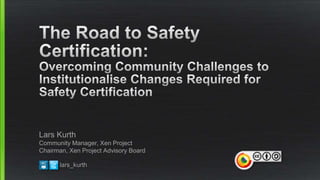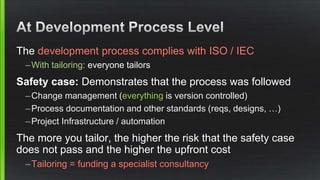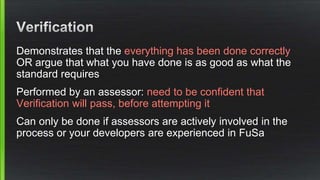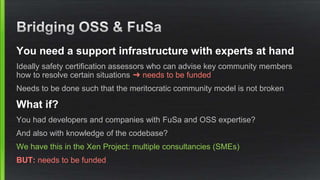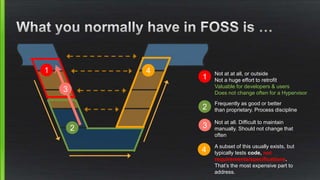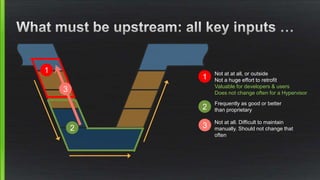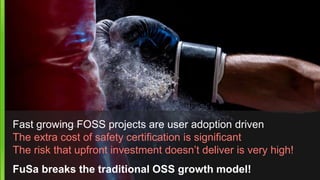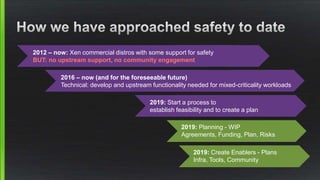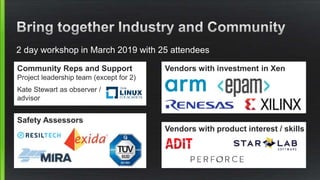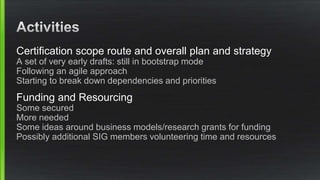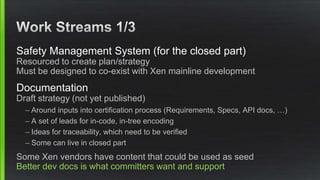OSSJP/ALS19: The Road to Safety Certification: How the Xen Project is Making Progress within the Auto Industry and Beyond - Lars Kurth, Citrix Systems UK Ltd.
- 1. Lars Kurth Community Manager, Xen Project Chairman, Xen Project Advisory Board lars_kurth
- 2. Why Virtualize Embedded Systems Hardware consolidation, Portability, Flexibility, Cost Xen and Embedded: A short History Multiple vendors targeting embedded and safety Use-Cases Production usage in non-safety and very few in a safety context The impact on the Xen Project Functionally a good platform for mixed-criticality workloads Reference stacks including Xen for automotive Safety certification needs to be resolved for wider adoption Safety Certification: A few highlights from our journey Will cover community aspects in more detail here static.sched.com/hosted_files/ossalsjp19/45/XenFusa-Overview-converted.pdf
- 4. Community Challenges Funding Yes, but there are many barriers Requires major changes to the software Requires good engineering practices and documentation? Requires tools, infrastructure and expertise Requires changes in how FOSS projects work Until recently: assumption was that the two worlds cannot work together
- 5. The product requirements are defined Demonstrate that these are correctly implemented by architecture, unit design, code –Reviews –Requirements traceability –Testing, including measurement of code coverage –Safety manual and analyses The requirements, architecture, unit design, code, testing comply to the best practices defined in the safety standards
- 6. The development process complies with ISO / IEC –With tailoring: everyone tailors Safety case: Demonstrates that the process was followed –Change management (everything is version controlled) –Process documentation and other standards (reqs, designs, …) –Project Infrastructure / automation The more you tailor, the higher the risk that the safety case does not pass and the higher the upfront cost –Tailoring = funding a specialist consultancy
- 7. Demonstrates that the everything has been done correctly OR argue that what you have done is as good as what the standard requires Performed by an assessor: need to be confident that Verification will pass, before attempting it Can only be done if assessors are actively involved in the process or your developers are experienced in FuSa
- 8. You must expect: –Major re-work of the codebase, including interfaces, modularity, reduction of complexity, … – Scale depends on target safety integrity/assurance level – And your starting point –Addition of missing artefacts: specifications, testing, etc. –To define your development process and extend/modify where there are gaps –Enforce the development process
- 10. Established developers don’t have a safety background Could be fixed by training: neither desirable, scalable or indeed necessary What you need: Sufficient awareness of concepts and terminology Bringing in new people / developers with relevant expertise Standards are typically proprietary and complex MISRA C Standard: licensed to a user @ approx. USD 15 Other standards are more expensive > USD 1000 Significant scope for different interpretations and tailoring It is absolutely essential that the project has access to specialist expertise
- 11. You need a support infrastructure with experts at hand Ideally safety certification assessors who can advise key community members how to resolve certain situations ➜ needs to be funded Needs to be done such that the meritocratic community model is not broken What if? You had developers and companies with FuSa and OSS expertise? And also with knowledge of the codebase? We have this in the Xen Project: multiple consultancies (SMEs) BUT: needs to be funded
- 12. Business Case Customer Requirements System Requirements High-Level Design Detailed Design Software Development Unit Testing Subsystem Verification System Verification System Validation Operation and Maintenance Changes and Upgrades System Validation Plan System Verification Plan Subsystem Verification Plan Unit / Test Plan Implementation Development Processes How do you map this onto a FOSS development process? How do you get community buy-in? How much can be tailored within ISO / IEC ? Agile and ISO / IEC can provide a model which may fit Traceability: how do you prove that design and architecture satisfies requirements and tests verify these also?
- 13. 1 2 4 1 Not at at all, or outside Not a huge effort to retrofit Valuable for developers & users Does not change often for a Hypervisor 2 Frequently as good or better than proprietary. Process discipline 4 A subset of this usually exists, but typically tests code, not requirements/specifications. That’s the most expensive part to address. 3 3 Not at all. Difficult to maintain manually. Should not change that often
- 14. 1 2 1 Not at at all, or outside Not a huge effort to retrofit Valuable for developers & users Does not change often for a Hypervisor 2 Frequently as good or better than proprietary 3 3 Not at all. Difficult to maintain manually. Should not change that often
- 15. Compilers, linkers, etc. Need to be certified – typically proprietary Such tools would need to be integrated into a CI gate In essence this means buying licenses and/or partnering with vendors Coding standard compliance Compliance checking tools for MISRA C Standard – typically proprietary There are some FOSS tools, which check subsets of the standard Again: needs CI integration and licenses and/or partnering with vendors Traceability Proof that tests satisfy requirements (and vice versa) Linkage between requirements and specifications (and vice versa) Commercial software is expensive and does not fit into an open source workflow Only 1 active project which does some of what is needed: Doorstop project
- 16. Required by most safety standards Misra C is a de-facto standard 10 Mandatory, 111 Required and 38 Advisory rules Required rules depend on certification level: can be deviated from Community Challenges Proprietary spec and tooling Coding guidelines and checking (e.g. via CI) How to avoid unnecessary discussion, while recognizing valid concerns How to deal with changes with high code churn (e.g. past supported releases and backporting of security fixes)
- 17. Fast growing FOSS projects are user adoption driven The extra cost of safety certification is significant The risk that upfront investment doesn’t deliver is very high! FuSa breaks the traditional OSS growth model!
- 18. How do we fund access to development tools and expertise? How do you fund filling the “gaps”? ELISA Project Founding members: Arm, BMW Car IT GmbH, KUKA, Linutronix, Toyota Reduce risk by providing tools, processes and patterns Zephyr Appears to be funded by Intel and some partners to establish Zephyr as a safety certifiable open source RTOS Xen Project So far on a per contributor basis from various organizations that have a vested in safety certifying Xen. Possible partnerships with assessors and tooling companies (in progress). Ultimately this is not going to be enough: approach is to make progress in some areas to demonstrate progress with reference implementations and unlock further funding.
- 20. 0 5 10 15 20 25 30 KSLOC 50 KSLOC 100 KSLOC 200 KSLOC Already investment of 20-30 man years on functionality: distributed and not all upstream An investment of 5-15 man years for 1-off safety certification is not outlandish But: can FuSa be maintained in an adapted FOSS model? Cost of certifying Xen based on study assuming a proprietary fork for DO-178 / DAL-C using experienced staff (domain +FuSa knowledge)
- 21. 2012 – now: Xen commercial distros with some support for safety BUT: no upstream support, no community engagement 2016 – now (and for the foreseeable future) Technical: develop and upstream functionality needed for mixed-criticality workloads 2019: Start a process to establish feasibility and to create a plan 2019: Planning - WIP Agreements, Funding, Plan, Risks 2019: Create Enablers - Plans Infra, Tools, Community
- 22. 2 day workshop in March 2019 with 25 attendees Community Reps and Support Project leadership team (except for 2) Kate Stewart as observer / advisor Vendors with investment in Xen Vendors with product interest / skills Safety Assessors
- 23. Create an understanding between the community and industry Terminology, Concepts, etc. How safety certification works: look at different standards, routes, requirements Explain assets and processes Establish “red lines” Principles the community can agree to or would object to What level of change would be acceptable Identify potential obstacles Establish whether Xen Project is safety certifiable If so, create a candidate set of feasible certification routes Establish a rough action plan on how to progress
- 24. Compared to Zephyr and ACRN it has an established user base in server, cloud and security applications on x86 Contributor community is diverse Xen on x86 is not really suitable today for embedded/mixed-criticality But Xen on Arm is: but was originally designed for servers Effort to redesign and refresh for mixed-criticality use-cases is scoped and sized Implementation and funding WIP ➜ opening to make this “safety-friendly” 25% 60% 15% common x86 arm Anything we do for safety can only be done if there is agreement to implement changes in a relevant subset of common code
- 25. Split development model with an open and a closed part Everything that is valuable to the wider community in the open part, e.g. documentation, tests (not all of them), traceability, automation and infrastructure,…. Everything that creates code churn if it wasn’t open as much as possible: e.g. coding standards (MISRA) Changes to the open development workflow are minimal There must be a benefit the community (including for common code) Broad agreement that codified requirements, more designs, more tests, traceability information are all beneficial for the project as a whole BUT: the workflow is git centric and there should not be no parallel universe of additional infrastructure and tools outside of git – Requirements, specs, etc. must all be stored in tree and covered by the projects review workflow – Traceability reports, etc. must be generated from in-tree artefacts
- 26. Filling the gaps Gaps in terms of documentation, specifications, safety manual must be developed and contributed by vendors interested in safety. Tests can be proprietary, if there is a 3rd party CI integration and commitment to triage and fix issues upstream (similar to what OpenStack does) There must be investment in necessary project infrastructure to enable this. Contributions have to be reviewed to go into mainline: there must be a commitment to “build new maintainers” (by above vendors performing code reviews) Maintaining Vendors will need to step up with maintainership, code reviews, test triage, supporting the new infrastructure, … Otherwise: all the initial work will become stale and will create burden for everyone else
- 27. You might have the coolest open-source project with a super complete feature-matrix that is safety-certifiable No-one will use it unless there is a clearly identified entity that is responsible for the safety sign-off for that project In the Split Development Model this can be done by –A commercial entity which is accountable: either a single vendor, multiple vendors or a group/consortium that collaborates with the community –Projects such as ELISA are also looking at this
- 28. Create reference stacks for safety use-cases supported by different vendors and eco-systems –Already have the EPAM automotive stack –Have a XILINX mixed-criticality stack –Another one in the pipeline (under NDA) –Others are being discussed/proposed by groups that previously were not engaged with Xen
- 30. Subgroups meet at least every other week. Partly resourced Community Reps Lars Kurth (chair and project mgmt) George Dunlap (committers) Stream Owners and Implementers Other Members Assessors Lars Kurth
- 32. Certification scope route and overall plan and strategy A set of very early drafts: still in bootstrap mode Following an agile approach Starting to break down dependencies and priorities Funding and Resourcing Some secured More needed Some ideas around business models/research grants for funding Possibly additional SIG members volunteering time and resources
- 33. Safety Management System (for the closed part) Resourced to create plan/strategy Must be designed to co-exist with Xen mainline development Documentation Draft strategy (not yet published) – Around inputs into certification process (Requirements, Specs, API docs, …) – A set of leads for in-code, in-tree encoding – Ideas for traceability, which need to be verified – Some can live in closed part Some Xen vendors have content that could be used as seed Better dev docs is what committers want and support
- 34. Verification Tests Focusing on CI capability vision and implementation first (CI v2 and v3) Some is resourced and aligns with plans the project already had Something the community wants and agreed to last week Capacity issue with traditional CIs that test on lots of different HW – Can’t integrate CI before start of code review – Too expensive to purchase HW and to maintain HW to enable needed scale – Issue: can’t test EVERY merge request – Front-load the review process with additional CI capability – Use automation bots as much as possible – For e-mail based code-review – Recently patchew, patchwork, lore have improved
- 35. Community Interactions and Processes Focusing on using FuSa to help address long-standing problems – With funding and resources This seems to work for now: the devil will be in the detail MISRA C compliance: needs planning and a process to find a compromise Process Automation Tools Surveying what is available, usable and a good baseline to extend – Dependency on ELISA Project MISRA C: looking at Perforce QA Verify, Bugseng Éclair and cppcheck
- 36. How to solve community Challenges for FuSa?
- 37. Most Challenges in FuSa are not solely Community Issues They only appear to be For Example: If there was adequate tooling for traceability which fits into a Git workflow, then moving closer to the V model (assuming it does not have to be serialized) only throws up community issues which have been resolved before – E.g. scaling up a community
- 38. Picture by Lars Kurth
Editor's Notes
- So the first question to ask is why to virtualize embedded systems at all And there we will look at Consolidation, Security and Safety and Special Requirements for Embedded Systems
- Need to make sure that what happens on the right sider: feeback
- The problem with funding: Most fast growing open source communities are driven by rapid end-user adoption which drives investment in the community (applies to all of CNCF and many other projects) BUT: to enable safety certification, the “prize” of a safety certifiable open source project, is much further down the line and investment is risky In other words: business cases are difficult to express and sell The Open Source movement has been though this before!
- 2 reference implementations Another one in the pipeline
- 16 mins
- 22 mins
- This is why proprietary vendors thrive in this space And why there are proprietary “forks” of open source software
- 16 mins
- 16 mins
- Unless you have significant resources it is not possible to test developer branches, and every merge requests for every configuration/HW combination before starting code reviews
